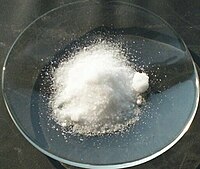
Photo from wikipedia
Stable suppression of nitrite-oxidizing bacteria (NOB) is still a major challenge for the implementation of partial nitritation and anammox (PN/A) in mainstream treatment. Despite numerous suppression strategies demonstrated, it is… Click to show full abstract
Stable suppression of nitrite-oxidizing bacteria (NOB) is still a major challenge for the implementation of partial nitritation and anammox (PN/A) in mainstream treatment. Despite numerous suppression strategies demonstrated, it is increasingly recognized that NOB could develop resistance to these strategies, threatening the long-term stability of the mainstream PN/A process. This study aims to understand adaption mechanisms and develop counter-strategies to overcome the adaptation. To this end, three previously-demonstrated suppression strategies, including NOB inactivation via side stream sludge treatment with free ammonia (FA), the use of low dissolved oxygen (DO), and the use of anammox to scavenge nitrite, were stepwise applied, over a period of 800 days, to a laboratory-scale reactor treating effluent from a high-rate activated sludge (HRAS) plant. FA sludge treatment alone sustained nitrite accumulation for about two months, after which NOB adaptation occurred causing PN to fail. The FA adaptation was induced by a shift in the NOB community from Nitrospira to Ca. Nitrotoga. The latter was found to have higher resistance to FA and also a higher maximum specific growth rate. Low DO at 0.2-0.4 mg O2 L-1 was then applied, in conjunction with FA treatment, which successfully eliminated Ca. Nitrotoga and re-established PN. However, new and unidentified NOB with a higher apparent oxygen affinity emerged in three months, again leading to PN failure. Lastly, as the third strategy for NOB suppression, anammox was introduced as an in-situ nitrite-scavenger. The combo-strategy delivered reliable NOB suppression with no further adaptation in the remaining experimental period (eight months). The resulted one-stage PN/A reactor achieved a nitrogen removal efficiency of 84.2 ± 5.37%. A control reactor, operated in parallel under the same conditions but without FA treatment, only achieved 10.4 ± 4.6% nitrogen removal, with anammox completely outcompeted by NOB in the last phase.
Journal Title: Water research
Year Published: 2021
Link to full text (if available)
Share on Social Media: Sign Up to like & get
recommendations!